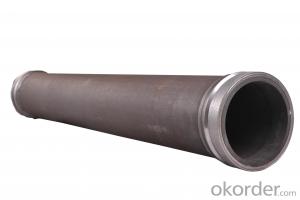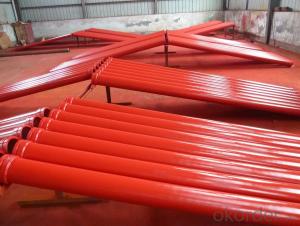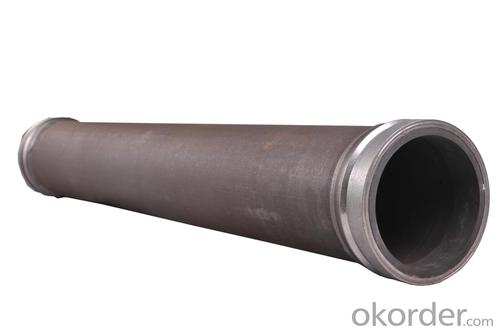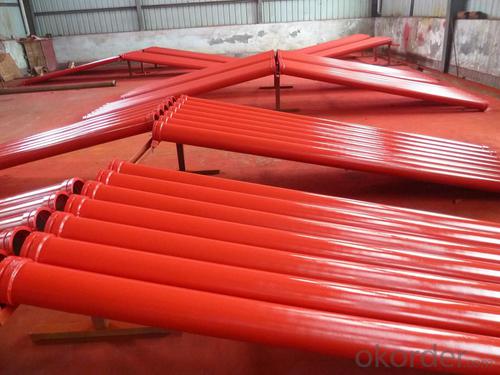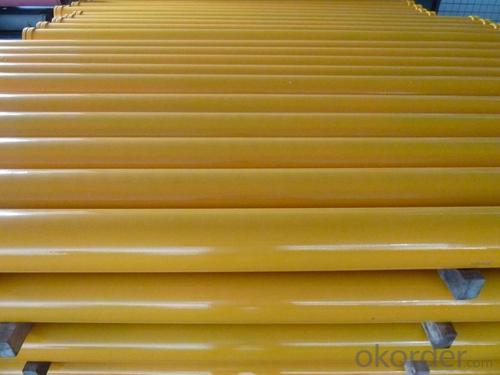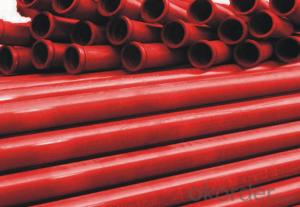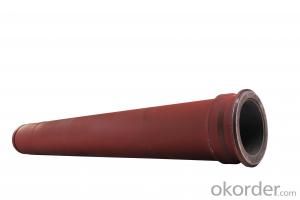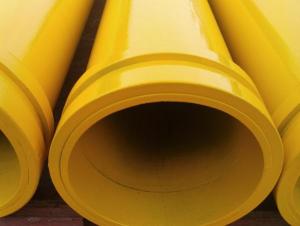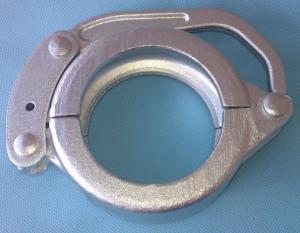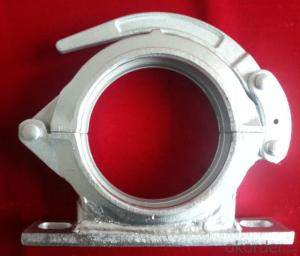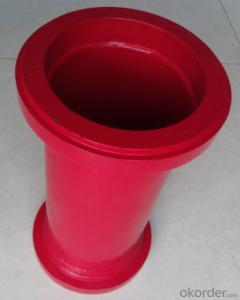Twin Wall Pipe for Concrete Pump Pipe Thickness 7mm Length 2000mm
- Loading Port:
- Tianjin
- Payment Terms:
- TT OR LC
- Min Order Qty:
- 50 pc
- Supply Capability:
- 2000 pc/month
OKorder Service Pledge
OKorder Financial Service
You Might Also Like
1. Diameter: DN125
2. Wall thickness: inner wall is 4 mm 65Mn, outer wall is 3mm seamless steel
3. Length: 3000&2000&1000mm with wear resistant SK flange
4. Type: Double / twin wall
5. Hardness: HRC 63
6. Using life: 60,000-100,000(CBM)
7. Highlights: longest using life
8. Welding: Smooth welding between straight pipes and flanges
9. Color : as customer's requirement,usually bule or red
10. Surface: Electrostatic Spraying Epoxy Paint
11. Packing: Wrapped by water proof poly-bag to protect the
painting and flanges & seaworthy
or according to customers’ requirements.
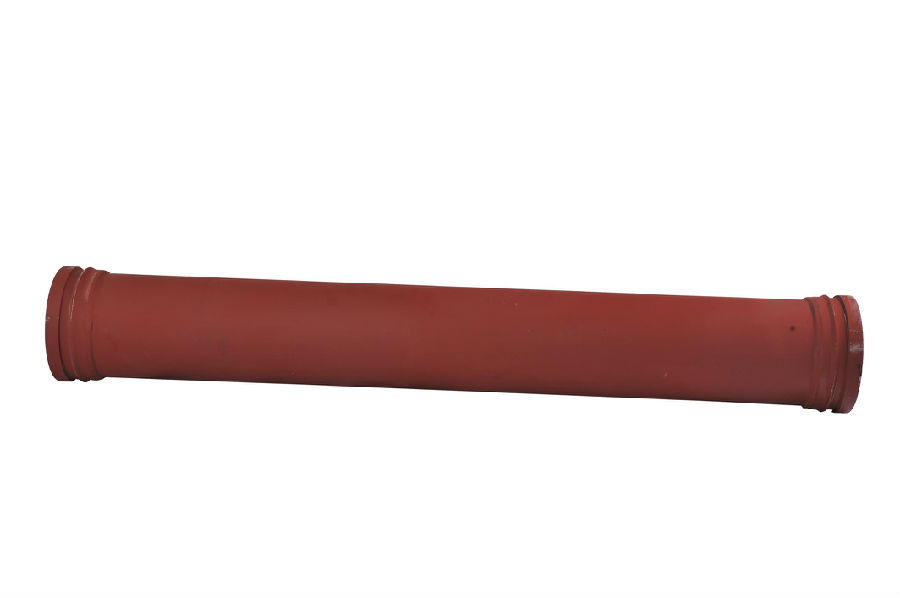
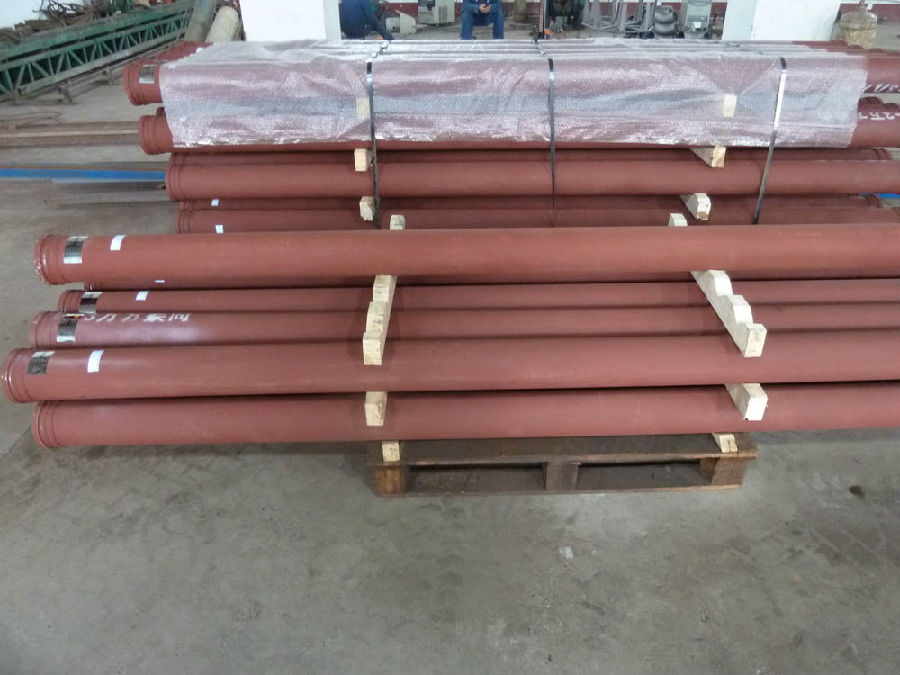
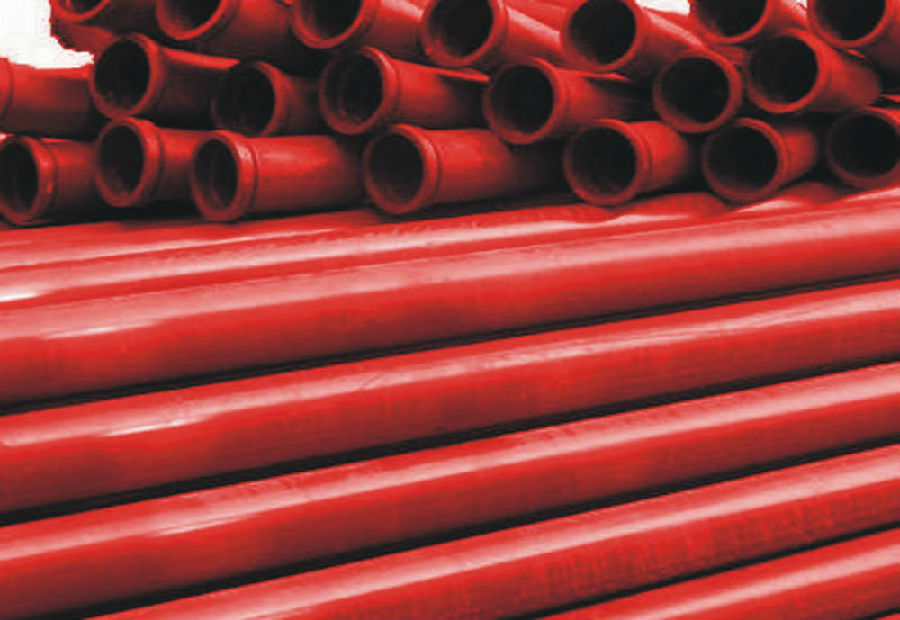
- Q: Are there any specific training or certifications required for handling and installing concrete pump spare parts?
- Handling and installing concrete pump spare parts necessitates specific training and certifications. Given the specialized nature of the equipment and the potential risks involved, individuals must undergo appropriate training and obtain relevant certifications. One must first acquire a comprehensive understanding of concrete pumps' functioning and components. This knowledge can be gained through extensive training programs offered by equipment manufacturers, industry associations, and vocational schools. These programs cover topics such as pump operation, maintenance, troubleshooting, and safety protocols. Furthermore, depending on jurisdiction or industry standards, specific certifications may be necessary. For instance, the American Concrete Pumping Association (ACPA) provides the ACPA Operator Certification, which requires individuals to demonstrate their proficiency in concrete pumping equipment, including the handling and installation of spare parts. Obtaining these certifications ensures that individuals possess the necessary knowledge and skills to handle and install concrete pump spare parts safely and efficiently. It also aids in complying with industry regulations and standards. It is crucial to note that the specific training and certification requirements may vary based on the region, industry, and type of concrete pump utilized. Therefore, it is advisable to consult local regulations and industry guidelines to ensure adherence to the requisite training and certification requirements for handling and installing concrete pump spare parts.
- Q: Are there any specific recommendations for the inspection and testing of concrete pump spare parts?
- Concrete pump spare parts come with specific recommendations for inspection and testing. To begin with, it is essential to visually examine the spare parts for any damage, such as cracks, dents, or excessive wear. Carefully inspect the parts for any irregularities or abnormalities. Next, it is advised to conduct non-destructive testing (NDT) to guarantee the integrity and quality of the spare parts. NDT methods like ultrasonic testing, magnetic particle testing, or dye penetrant testing can be utilized to identify any hidden flaws or defects in the parts. These tests are beneficial in detecting potential issues that might impact the performance or safety of the concrete pump. Additionally, it is recommended to verify the dimensions and tolerances of the spare parts to ensure they adhere to the manufacturer's specifications. Precision measuring tools can be employed to compare the measurements with the required specifications. Any deviations should be documented and addressed accordingly. Furthermore, functional testing should be carried out to ensure that the spare parts are functioning as intended. This involves installing the parts in the concrete pump and conducting various tests to verify their functionality and performance. For instance, the pump's flow rate, pressure, and efficiency can be tested to ensure optimal performance. Lastly, it is of utmost importance to adhere to the manufacturer's guidelines and recommendations for inspecting and testing concrete pump spare parts. These guidelines provide specific instructions and procedures for accurately and safely inspecting and testing each type of spare part. It is crucial to consult the manufacturer's documentation and seek professional advice if necessary.
- Q: What is the name of the pump for concrete transportation?
- The concrete pump truck is divided into piston type, extruding type and water pressure diaphragm type according to the structure form. The pump body is mounted on the automobile chassis, and then equipped with telescopic or bent cloth rods to form a pump truck
- Q: Can I get spare parts for both concrete pumps with and without pressure washers?
- Spare parts for both concrete pumps with and without pressure washers are readily available. Numerous manufacturers and suppliers offer an extensive selection of spare parts for concrete pumps, even those equipped with pressure washers. These spare parts consist of various components, including hoses, nozzles, valves, cylinders, seals, filters, and other necessary accessories for proper concrete pump operation. It is crucial to maintain and promptly replace worn-out or damaged parts to guarantee optimal performance and long-lasting equipment, regardless of whether your concrete pump has a pressure washer or not.
- Q: What are the different types of concrete pump hydraulic pumps?
- Concrete pumps commonly utilize a variety of hydraulic pumps. Here are several types: 1. Gear pumps, which are widely employed in concrete pumps, consist of meshing gears that propel hydraulic fluid from the inlet to the outlet. Gear pumps are renowned for their simplicity, durability, and reliability. 2. Piston pumps, another popular choice in concrete pumps, employ reciprocating pistons to move hydraulic fluid. These pumps are known for their ability to handle heavy-duty applications and generate high pressure. 3. Vane pumps are often used in smaller concrete pumps or as auxiliary pumps in larger ones. They rely on rotating vanes within a housing to move the hydraulic fluid. Vane pumps are prized for their compact size and efficiency. 4. High-pressure concrete pumps commonly employ radial piston pumps. These pumps have multiple pistons arranged radially around a central shaft. The pistons' alternating motion creates the pumping action. Radial piston pumps are esteemed for their power and efficiency. 5. Large concrete pumps frequently utilize axial piston pumps. These pumps feature multiple pistons arranged in a circular pattern around a central shaft. The pistons move linearly to generate the pumping action. Axial piston pumps excel in high flow rates and pressure capabilities. Ultimately, the choice of hydraulic pump for a concrete pump depends on factors such as pump size, desired pressure and flow rate, and specific application requirements.
- Q: How do I properly maintain and replace hydraulic pumps in concrete pump spare parts?
- Proper maintenance and replacement of hydraulic pumps in concrete pump spare parts involve a few key steps. Firstly, it is crucial to regularly inspect the hydraulic pump for any signs of wear, leaks, or damage. This includes checking the fluid levels, filters, and hoses. Secondly, following the manufacturer's guidelines, ensure that the hydraulic pump is regularly serviced and that the recommended maintenance tasks are performed on schedule. This includes changing the hydraulic fluid, replacing filters, and lubricating moving parts. Lastly, when it comes to replacing hydraulic pumps, it is important to use genuine and compatible spare parts that are recommended by the manufacturer. Additionally, it is advisable to seek professional assistance or consult the manufacturer's instructions to ensure proper installation and alignment of the new pump.
- Q: What are the advantages of using tungsten carbide components in concrete pump spare parts?
- There are several advantages of using tungsten carbide components in concrete pump spare parts. Firstly, tungsten carbide is an extremely hard and durable material, which ensures longer lifespan and increased wear resistance of the components. This means reduced maintenance and replacement costs in the long run. Additionally, tungsten carbide has excellent corrosion resistance, making it suitable for use in harsh and corrosive environments commonly found in concrete pumping applications. Furthermore, tungsten carbide components offer superior strength and toughness, enabling them to withstand high-pressure and heavy-duty operations without compromising performance. Overall, the use of tungsten carbide in concrete pump spare parts leads to improved efficiency, reliability, and cost-effectiveness in concrete pumping operations.
- Q: Are there any specific safety precautions while replacing concrete pump spare parts?
- There exists a variety of safety precautions that must be followed when replacing concrete pump spare parts. 1. Personal Protective Equipment (PPE) is of utmost importance and should be worn to safeguard against potential hazards. This includes safety goggles, gloves, a helmet, and steel-toed boots. 2. It is essential to adhere to proper lockout/tagout procedures prior to replacing any spare parts. This entails disconnecting and securing the power source to prevent accidental startup of the pump. 3. Before commencing the replacement process, inspect all tools and equipment for any indications of damage or defects. It is crucial to refrain from using faulty equipment, as it can pose significant safety risks. 4. When handling heavy spare parts, it is imperative to employ appropriate lifting techniques to prevent strain or injury. Ensure that proper assistance and equipment, such as cranes or forklifts, are available if necessary. 5. Maintain a clean and well-organized work area to prevent trips, slips, and falls. Remove any obstacles or debris that may jeopardize safety during the replacement process. 6. Only trained and authorized personnel should be involved in the replacement of concrete pump spare parts. They must possess a thorough understanding of the equipment and procedures to minimize the likelihood of accidents. 7. Always consult the manufacturer's guidelines and instructions when replacing spare parts. This will ensure that the process is executed safely and accurately. 8. It is vital to have a plan in place for potential emergencies, including fires or injuries. Make certain that fire extinguishers and first aid kits are easily accessible, and that all workers are familiar with their locations and usage. By adhering to these safety precautions, the risk of accidents, injuries, and damage can be significantly reduced when replacing concrete pump spare parts.
- Q: What is the purpose of a concrete pump piston?
- The purpose of a concrete pump piston is to pressurize and push the concrete mixture through a pipeline, enabling efficient and accurate placement of the concrete in construction projects.
- Q: What are the indications of a clogged or damaged concrete pump filter?
- The indications of a clogged or damaged concrete pump filter can include decreased flow rate, loss of pressure, irregular or uneven concrete distribution, increased wear and tear on the pump system, and potential blockages or breakdowns in the pump.
Send your message to us
Twin Wall Pipe for Concrete Pump Pipe Thickness 7mm Length 2000mm
- Loading Port:
- Tianjin
- Payment Terms:
- TT OR LC
- Min Order Qty:
- 50 pc
- Supply Capability:
- 2000 pc/month
OKorder Service Pledge
OKorder Financial Service
Similar products
Hot products
Hot Searches
Related keywords
